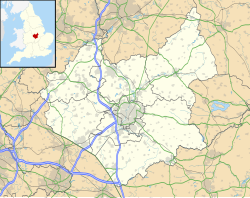| Shearsby | |
|---|---|
 Shearsby | |
Location within Leicestershire | |
| Area | 1.76 sq mi (4.6 km2) |
| Population | 240 (2011) [1] |
| • Density | 136/sq mi (53/km2) |
| OS grid reference | SP623908 |
| • London | 85 mi (137 km) |
| District | |
| Shire county | |
| Region | |
| Country | England |
| Sovereign state | United Kingdom |
| Post town | LEICESTER |
| Postcode district | LE8 |
| Dialling code | 0116 |
| Police | Leicestershire |
| Fire | Leicestershire |
| Ambulance | East Midlands |
| UK Parliament | |
Shearsby is a rural village in the English county of Leicestershire. Shearsby is in the Harborough district around nine miles due south of Leicester and north east of Lutterworth. The population of the civil parish at the 2011 census was 240. [1]


